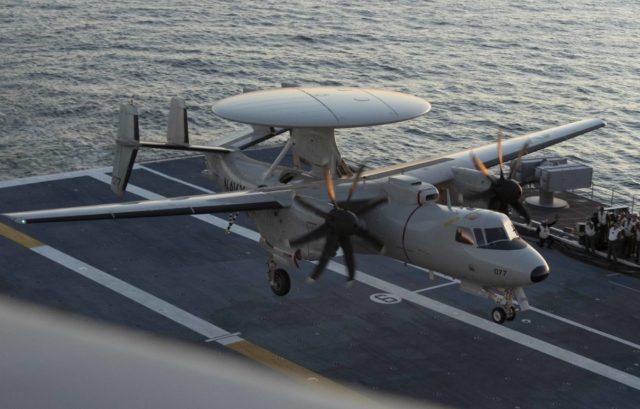
USS Gerald R. Ford (CVN 78), the first new-design aircraft carrier in 40 years and the US Navy’s most expensive warship ever built, got underway from its Norfolk homeport to begin aircraft compatibility testing (ACT).
On January 16, an E-2D Advanced Hawkeye early warning aircraft become the first plane to land on the carrier off the East Coast.
ACT continues the at-sea testing of Electromagnetic Aircraft Launch System (EMALS) and Advanced Arresting Gear (AAG) – two Aircraft Launch and Recovery Equipment (ALRE) systems unique to Ford – previously conducted in 2018 by the F/A-18 E/F Super Hornet.
During this upcoming phase of ACT, compatibility testing will include: T-45 Goshawks, F/A-18 E/F Super Hornets, and E/A-18G Growlers from Air Test and Evaluation Squadron 23 (VX-23); and E-2D Advanced Hawkeyes and C-2A Greyhounds, from Air Test and Evaluation Squadron 20 (VX-20). This will be the first time the T-45, E-2D, C-2A and E/A-18G aircraft will launch and recover from the navy’s newest aircraft carrier.

“Ford is now proving all of the test-work accomplished at Joint Base McGuire-Dix-Lakehurst, N.J. over the last year-and-a-half, that we can fly fleet aircraft as a ship with EMALS and AAG integrated,” said Cmdr. Mehdi “Metro” Akacem, Ford’s Air Boss. “This is very exciting, and it is the culmination of a year-and-a-half of training, anticipation, and teamwork.”
Ford last flew aircraft in January 2018 and has 747 launches and arrestments to date. This round of testing will allow the crew to further test the improvements made during its post-shakedown availability (PSA) at Huntington Ingalls Industries-Newport News Shipbuilding while also allowing the crew to gain experience on these unique systems.
EMALS is the launch system of choice for Ford and all future Ford-class aircraft carriers. Its mission and function remains the same as traditional steam catapults; however, it employs entirely different technologies. EMALS uses stored kinetic energy and solid-state electrical power conversion. This technology permits a high degree of computer control, monitoring and automation. The system will also provide the capability for launching all current and future carrier air wing platforms – lightweight unmanned to heavy strike fighters.
The software-controlled AAG is a modular, integrated system that consists of energy absorbers, power conditioning equipment and digital controls, with architecture that provides built-in test and diagnostics, resulting in lower maintenance and manpower requirements. AAG is designed to provide higher reliability, increased safety margins and reduce the fatigue impact load on aircraft. Similar to EMALS, it will also allow for the arrestment of all current and future air wing assets.
As the first ship in a new class and featuring a number of new technologies, the ship is tackling issues related to a number of the installed systems.
In addition to challenges in building, testing, and certifying the ship’s weapon elevators, the navy reportedly has been working to address problems with other systems on the ship, including its propulsion and electrical systems.
According to a Congressional Research Service report from December 2019, technical issues regarding the weapon elevators and other ship systems have delayed the ship’s first deployment to 2022 at the earliest, which would be about five years after the ship was commissioned into service.


























